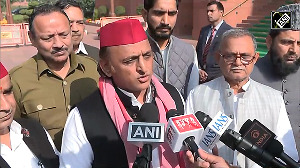As India gets set to play its 500th Test, Rajneesh Gupta presents India's memorable Test victories at home.

India will become only the fourth nation to feature in 500 Tests when they play New Zealand in the first Test in Kanpur.
England (976), Australia (791) and West Indies (517) are the other countries to have played 500 or more Test matches.
There have been countless memorable performances by India, who first played a Test way back in 1932 when they clashed against England at Lord's in 1932.
In the last couple of decades, the Indians have emerged as a potent force in Tests, especially at home where their spinners have been a force to reckon with.
To celebrate the historic 500 Test landmark, Rajneesh Gupta presents India's memorable Test victories at home.
vs England at Madras, 1952. Won by an innings and 8 runs
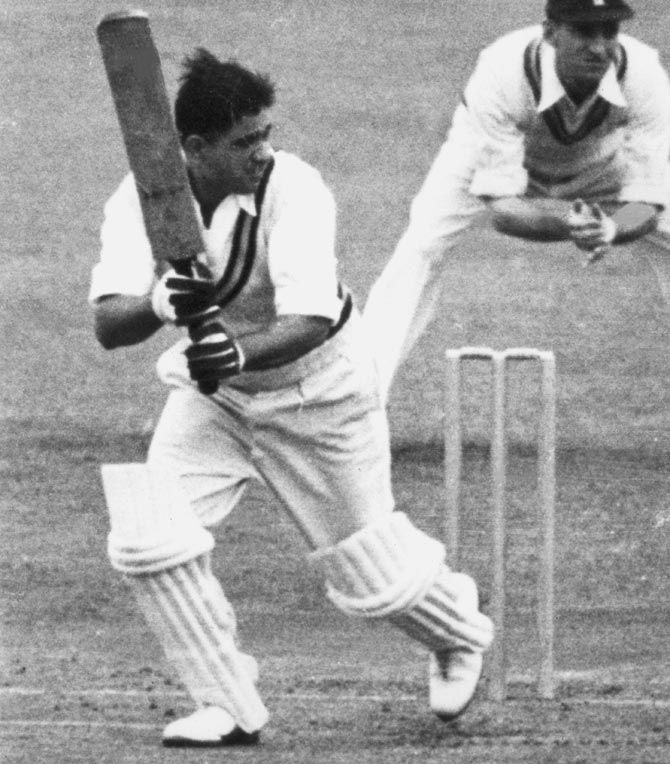
India recorded its first Test victory in style -- winning by an innings.
It was India's 25th Test and victory was set up by left-arm spinner Vinoo Mankad, who bowled superbly in both innings, returning with 12 wickets in the match for 108 runs.
His figures of 8/55 in the first innings and his match figures are still the best bowling figures for India against England.
There were four stumpings in the innings, and five in the match, for Khokhan Sen -- all off Mankad -- both records until Kiran More (thanks to Narendra Hirwani) bettered it in 1987-1988 against the West Indies.
Mankad added four more wickets in the second innings, and with Pankaj Roy (111) and Polly Umrigar (130) making hundreds, England were beaten by an innings and eight runs before tea on the fourth day.
vs Australia at Kanpur, 1959, Won by 119 runs
Off-spinner Jasu Patel was the architect of India's first-ever win over Australia, with match figures of 14 for 124.
Recalled after three years, Patel, 35, was almost unplayable on a newly laid turf pitch at Kanpur's Green Park.
His first innings figures of 9/69 were the best by an Indian bowler in Tests until Anil Kumble bettered them against Pakistan at Delhi in 1999.
His match figures were also an Indian record until Narendra Hirwani bettered them.
Surprisingly, in his six other Test appearances, Patel managed a mere 15 wickets -- never taking more than three wickets in an innings!
vs Australia at Mumbai, 1964. Won by 2 wickets

India won by two wickets and drew level in the series after a close fight.
The result may have been different had Norman O'Neill been fit. He went down with stomach pains just after the start and could not bat in either innings.
Australia, who won the toss, lost three wickets for 53 before Bob Cowper and Peter Burge added 89 in 80 minutes. Burge hit 15 4s in his 80, made in 115 minutes. Even so, five wickets fell for 146, but recovery came from Tom Veivers and Barry Jarman, who put on 151.
India batted slowly, and recovered from a moderate start. Captain Mansur Ali Khan 'Tiger' Pataudi and the lower order batsmen were largely responsible for the last four wickets adding 153 as the hosts grabbed a vital 21 run lead.
Australia scored 246 in the second innings.
Needing 254 to win, India were 74 for three overnight, but on the last day, before a crowd of 42,000, won with half an hour to spare.
At 122/6, India looked in trouble, but Pataudi, who hit a half century in both innings, and Vijay Manjrekar turned the tide with a partnership of 93.
vs England at Kolkata, 1973. Won by 28 runs
70,000 people watched India registering a thrilling 28 run win. With the outcome unpredictable till the last ball, spectators were kept on their toes.
England, who beat India in the first Test, bowled and fielded well in seamer-friendly conditions, to restrict India to 210.
The visitors had no answer to the guile of India's spinners as Bhagwat Chandrasekhar (5/65), Erapalli Prasanna (3/33) and Bishen Singh Bedi (2/59) sent the Englishmen packing for 174.
The hosts failed to capitalise on the lead and were bowled out for 155 in the second innings.
Needing 191 runs to win, England had a disastrous start, losing four wickets for just 17 runs. There was brief resistance from the middle order, as Mike Denness and Tony Greig added 97 runs for the fifth wicket.
Chandrasekhar got rid of the dangerous Greig and wickets fell in a heap thereafter.
At 138/9, it looked all over for England, but Chris Old and Bob Cottam refused to bow down without a fight. They took the score to 160 at lunch on day five. The break proved a blessing for India as in his first over after lunch Chandra trapped Cottam leg before wicket, to steer India to a thrilling win.
Bedi (5/63) and Chandra (4/42) were the wreckers-in-chief for India, with the unorthodox leg-spinner claiming 9 wickets in the match.
vs Pakistan at Madras, 1980. Won by 10 wickets
The resounding victory in the fifth and final Test gave India a series win over their arch rivals in Chepauk, Madras.
The only previous series India had won against Pakistan was the first one between the two countries in 1952.
Sunil Gavaskar's 166 set India on the right path, but the real hero was Kapil Dev, who was establishing himself as one of the world's leading all-rounders.
He took 4/90 and 7/56 in the two innings and smashed a quickfire 84 to play a big role in a famous win.
Kapil became the first Indian to score a 50 and take 10 wickets in the same Test -- a feat no other Indian has emulated till date.
vs England at Mumbai, 1984. Won by 8 wickets
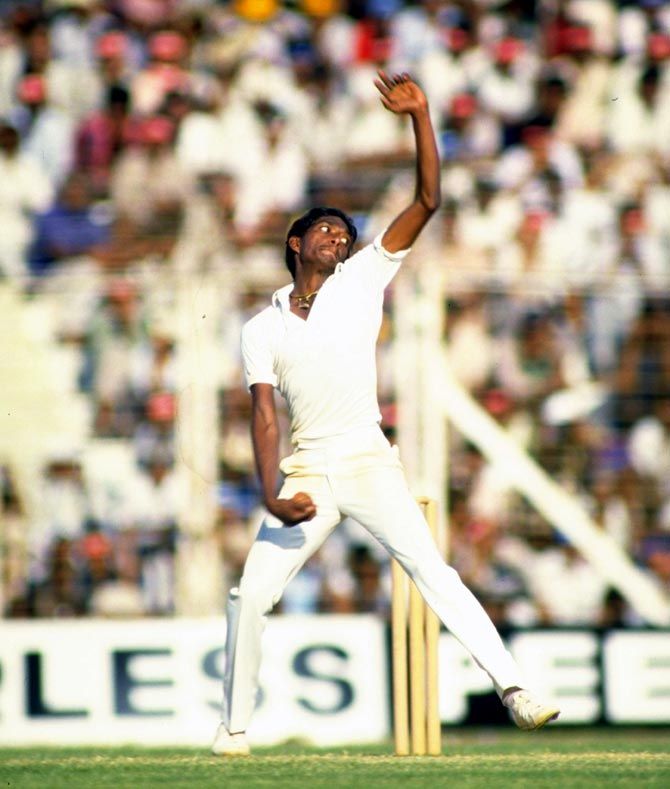
India ended a run of 31 Tests without victory courtesy of a entertaining victory against David Gower's England team at the Wankhede stadium in Mumbai.
Leg-spinner Laxman Sivaramakrishnan was making a comeback into Indian side after an uneventful debut Test 19 months earlier.
He dismissed opener Graeme Fowler, having him caught and bowled off a full toss. This triggered a collapse from which England never recovered, with 7 wickets falling for 68 on a slow pitch of even bounce as the visitors folded for 195.
India were in danger of losing the advantage when they lost their fifth wicket on 156. It could have been even worse, but Ravi Shastri survived a straightforward stumping chance at 38 off Phil Edmonds. He and Syed Kirmani turned the game around with an Indian seventh wicket record stand of 235.
When they were out to successive balls, caught by Allan Lamb at deep mid wicket, both had made maiden hundreds against England.
Kirmani was dismissed first, after scoring 102, while Shastri hit a fluent 142, laced with 17 fours and a six in 390 minutes, a composed innings which showcased that he could hold his Test place on his batting skill alone.
England, needing 270 to make India bat again, lost Tim Robinson to a dubious lbw decision against Kapil in the final 50 minutes of the third day's play. India were kept waiting till 45 minutes after lunch on the fourth day for their next success, Fowler and Mike Gatting adding 135 in 199 minutes on a slow, turning pitch.
Fowler was trapped leg before by Siva before Gower was caught at silly point off Shastri. Next over, when Lamb was brilliantly stumped by Kirmani off Siva, bowling from round the wicket, England had slumped from 138/1 to 152/4 in 27 minutes.
Chris Cowdrey was caught at silly point off Shivlal Yadav. Gatting, sensing an assault was needed for England to escape, scored 40 off his final 46 runs in fours. Siva brought an end to his entertaining knock, deceiving him in the air, as he was caught at long off.
Gatting had batted for more than five hours for his 136 which included 21 fours. Pat Pocock batted for 78 minutes on the last day and added 62 for the 9th wicket with wicket-keeper Paul Downton, but the writing was on the wall.
The innings ended at 317, giving Siva match figures of 12/181 -- the second best figures by an Indian bowler against England. He also became the youngest Indian to bag 10 wickets in a Test match.
India cruised to an emphatic eight wicket win.
vs West Indies at Madras, 1988. Won by 255 runs
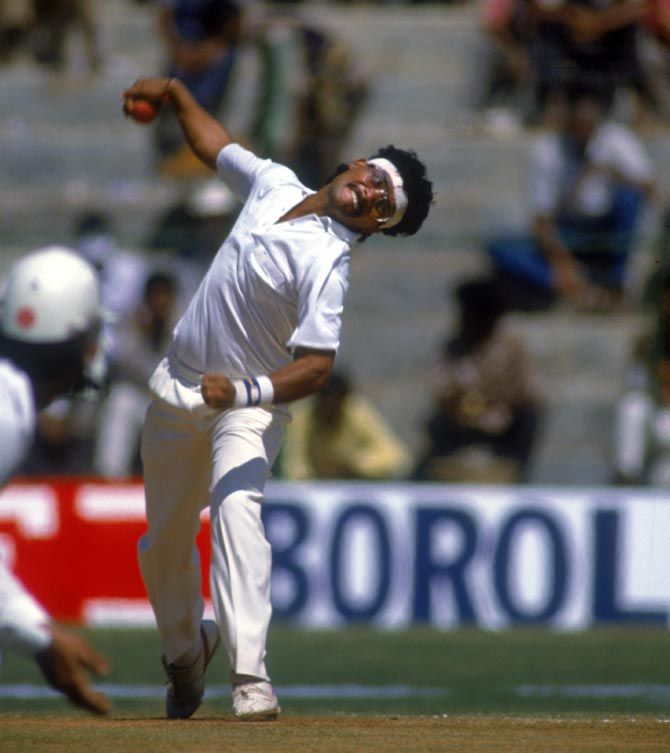
The final Test of a four match series saw a dream debut by 19-year old leg-spinner Narendra Hirwani whose 16 wickets in the game brought India a crushing victory to draw level in the series.
A brilliant 109 by Kapil Dev ensured that the advantage of Ravi Shastri, who took over as Indian captain from the injured Dilip Vengsarkar, of winning the toss was fully exploited.
He reached his 100, his sixth in Test cricket and his third against the West Indies from 105 balls in 153 minutes with 17 fours, adding 113 for the sixth wicket with Mohammad Azharuddin.
Hirwani only bowled 203 balls in the match and conceded more than four runs an over but he captured 16 wickets for 136, to register the most successful debut by a bowler in the history of Test cricket, just edging out Bob Massie, who took 16 wickets for 137 against England at Lord's in 1972.
His figures of 8/61 in the first innings were the third best by a Test debutant as the West Indies only just avoided the follow-on.
Then, after W V Raman, also on his Test debut, scored 83 to take India's overall lead to 415, Hirwani took another eight wickets to finish with the third best match figures (then) in Test history.
India's margin of victory was then its second largest in Test cricket and the win ensured that Viv Richards' side could only draw a series for the third time in succession.
vs England at Kolkata, 1993. Won by 8 wickets
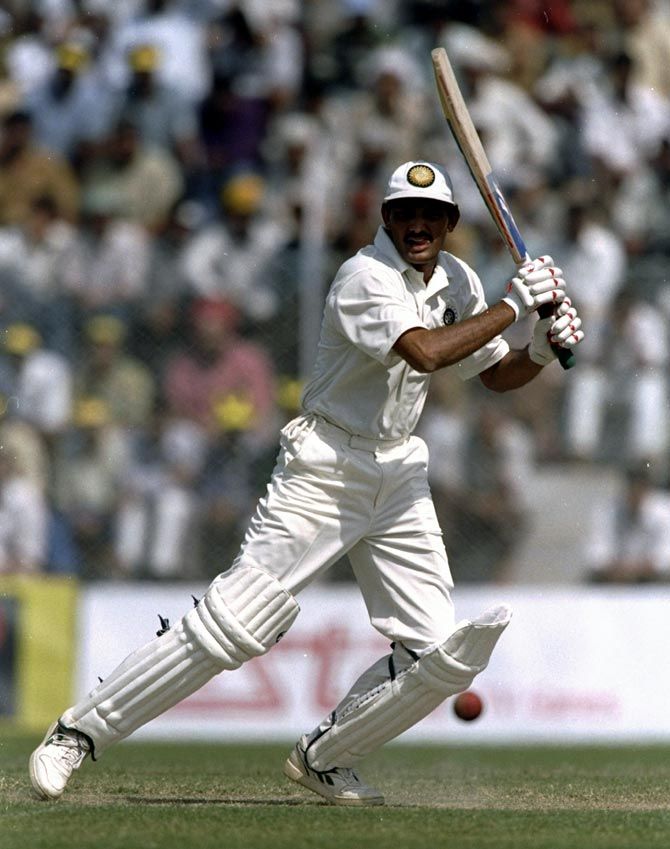
Before the start of the series, the mood in the Indian camp was sombre. India had returned from an unsuccessful tour of South Africa. They had, in fact, won only one of their last 25 Tests before taking on Graham Gooch's team.
Mohammad Azharuddin's captaincy and the Indian team's ability to win were both being questioned before everything changed within a month.
India had three spinners -- leg-spinner Anil Kumble, left-arm spinner Venkatapathy Raju and off-spinner Rajesh Chauhan. England, quite inexplicably, chose to go with a four man pace attack.
Ian Salisbury, who had only recently been elevated in status from net bowler to a full member of the squad, was picked at the expense of the two experienced spinners, Phil Tufnell and John Emburey.
Azhar won the toss and had no hesitation in opting to bat first. India were in some kind of bother when the skipper came out to bat, having lost three wickets with only 93 runs on the board.
By the time he was dismissed, England were out of the contest. Azharuddin produced an innings of masterful strokeplay matched with watchful defence, smashing his way to 182 off just 197 balls.
England needed 172 to avoid the follow on, but fell nine runs short as they crumbled against the Indian spinners. They collapsed to 88/5 at the end of the second day and eventually to 163 all out. The Indian spinners took three wickets each.
Gooch and Alec Stewart gave England a solid start in the second innings, before Gooch was dismissed in weird circumstances. He momentarily lifted his back foot from the batting crease and the ever alert wicket-keeper Kiran More whipped off the bails.
Gatting, returning to Test cricket after his ban for touring South Africa, held out doggedly. He made good use of the sweep shot, but the very shot brought his downfall as well. With only 16 short of making India bat again, Gatt attempted to sweep a wider delivery from Chauhan and dragged the ball back on to his stumps.
India were left to score 79 runs to win. They ended the day four with 36 for no loss. Around 25,000 spectators assembled on the final morning to watch India score the last 43 runs required for victory.
The thumping victory was celebrated in Calcutta style -- thunderflashes, firecrackers and all.
v South Africa at Ahmedabad, 1996. Won by 64 runs
Javagal Srinath's devastating pace bowling gave India victory on a poor pitch in Motera, Ahmedabad.
Though it seemed best suited to the spinners, Srinath's fast, accurate in-swingers and off-cutters brought him career best figures of 6/21. South Africa crashed to 105 after being set a modest 170 to win.
Sachin Tendulkar took charge of the captaincy from Azharuddin, who became the first cricketer to play against all eight other countries, both home and away.
It was obvious that batting would not be easy on the brown, dusty pitch, and by winning the toss Tendulkar gave India a substantial advantage.
India struggled against accurate bowling and sharp fielding. Allan Donald was superb, but the two most critical blows were struck by Jonty Rhodes. He held a dazzling diving catch at mid-wicket to dismiss Tendulkar and then ran out Azhar with a direct hit from cover.
Having restricted India to 223, South Africa needed to bat sensibly. Instead, they slumped to 119/7. No 9 Fanie de Villiers (67) showed the application needed over three hours: with first Pat Symcox (32), and then Donald (17), as the Proteas added 125 runs for the last three wickets to establish a 21 run lead.
Donald struck twice before India erased the modest deficit. They were 38/3 when Tendulkar sliced a slower delivery form Brian McMillan to Rhodes at backward point. It was to be Rhodes' last significant contribution: He later strained his hamstring badly.
Donald had Azhar brilliantly caught at second slip by McMillan, and, when Rahul Dravid was trapped by Symcox, India were just 70 ahead with five down.
V V S Laxman, the 22-year-old debutant, showed great temperament as he played a good innings of 51, adding 56 runs for the 8th wicket with Anil Kumble to push India's total to 190.
Needing 170, with nearly two days to get the runs, South Africa looked to their openers for a solid start before the spinners came on. Instead, Srinath took centre stage. He trapped Andrew Hudson with his fifth delivery in the second innings and then had Daryl Cullinan caught behind off the next as the South Africans were two down without a run on the board.
With captain Hansie Cronje the only batsman to last long, his team never looked like reaching the target. Srinath's pace and swing combined perfectly with Kumble's customary accuracy on a crumbling pitch which made driving through the line virtually impossible.
From 96/4, South Africa lost their last six wickets for nine runs to be bowled out for 105.
vs Pakistan at Delhi, 1999. Won by 212 runs
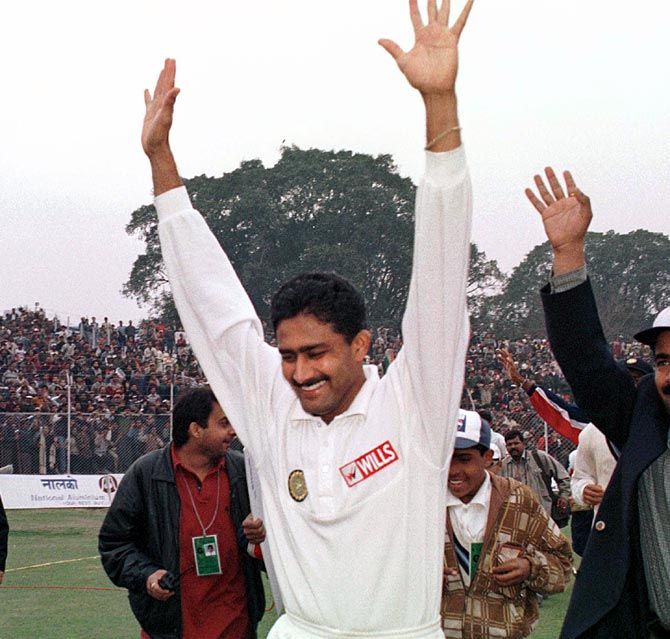
History was created on February 7, 1999 at the Feroz Shah Kotla in New Delhi as Anil Kumble became only the second player after England's Jim Laker to claim all ten wickets in a Test innings.
The record haul helped India beat Pakistan for the first time since 1980.
Kumble took all his wickets from the Pavillion End in a sequence of 18.2-9-37-10 on either side of the tea interval on Day 4.
This was after Pakistan -- set to score an improbable target of 420 -- were off to a rollicking start, with Saeed Anwar and Shahid Afridi putting on a century opening partnership. Once this partnership was broken, Kumble ran through Pakistan batting line-up.
vs Australia at Kolkata, 2001, Won by 171 runs

Regarded as one of the greatest Test matches of all time, the second Test at the Eden Gardens in Kolkata in March 2001 saw India snatch victory from the jaws of defeat against the all-conquering Australians, breaking several records and registering only the third victory in Test history for a side who had followed on.
Australia were the losers in the previous instances too, losing to England at Sydney in 1894-1895 and Leeds in 1981.
The 'Very, Very Special' V V S Laxman played a magical innings of 281, then the highest Test score for India, and was involved in a record stand of 376 with Dravid -- an Indian 5th wicket record.
Their feats almost overshadowed the outstanding performance of off-spinner Harbhajan Singh, who claimed India's first Test hat-trick while capturing a career best seven wickets in the first innings, and followed up with a match-winning six in the second.
Australia scored a formidable 445 in the first innings, largely due to a stubborn 9th wicket partnership between skipper Steve Waugh and Jason Gillespie, after they lost six wickets in the space of 26 overs and 76 runs.
Harbhajan, who bagged a hat-trick, was responsible for Australia's late collapse. Australia were 269/8, but India were kept in the field until an hour after lunch on the second day as Steve Waugh batted more than five hours to orchestrate the revival.
Tailenders Gillespie, who shared a stand of 133, an Australian 9th wicket record against India, and Glenn McGrath lent noble support until Waugh was last out for 110.
The pitch was playing easily, yet India got into a terrible mess. All the Aussie bowlers succeeded but, predictably, McGrath dominated with 4/18 in 14 overs.
If there was a silver lining to the debacle, it was that Laxman's swashbuckling 59 from 83 balls prompted his promotion from No 6 to No 3 when India followed on having conceded a huge 274 run lead.
The tall Hyderabad batsman responded to the responsibility with a flawless and elegant display of batting that stretched over 10 hours, 31 minutes, during which he faced 452 balls, picked up 44 fours with a wide range of exciting shots, leaving even the great Shane Warne clueless as Laxman used his wrists and footwork to good effect against the leggie.
He comfortably surpassed India's previous best, Sunil Gavaskar's 236 not out against the West Indies at Madras in 1983-1984.
India lost four wickets before the deficit was cleared, but as Dravid's batting recovered its sparkle in Laxman's company, the game was transformed.
They batted together for 104 overs, including the whole of the fourth day, when they added 335 in 90 overs. Their stand of 376 overtook India's 5th wicket record, a mere 214 between Azharuddin and Shastri against England on the same ground in 1984-1985, and then India's all-wicket record against Australia, an unbroken 298 for the 6th wicket between Vengsarkar and Shastri at Bombay in 1986-1987.
By the time Laxman was out, it was the second highest partnership for any Indian wicket, behind the opening stand of 413 between Vinoo Mankad and Pankaj Roy against New Zealand at Madras in 1955-1956, and the third best by any country for the fifth wicket.
Their efforts not only dispelled India's troubles, but opened up an avenue to a momentous victory. Dravid was eventually run out for a gutsy 180 from 353 balls in 7 hours 24 minutes, with 21 fours.
When skipper Ganguly declared with a big lead of 383, India had equalled the second highest Test total by a side batting second, 657/8 by Pakistan at Bridgetown in 1957-1958. Only New Zealand, with 671/4 against Sri Lanka at Wellington in 1990-1991, had scored more runs.
It meant Australia had to bat out 75 overs for a draw, on a pitch affording turn without being devilish. Their prospects looked good when Matthew Hayden, given an early life, and Michael Slater stayed together for 23 overs. But once they were separated, wickets fell at regular intervals.
The only pause in the collapse was provided by a 4th wicket partnership of 50 between Hayden and Steve Waugh.
Harbhajan did the major damage, and Tendulkar, bowling leg-spin, took three wickets, including the crucial ones of Hayden and Adam Gilchrist for a king pair. Australia were all out in the 69th over and their record run of 16 Test wins came to an abrupt and spectacular halt.
vs Australia at Chennai, 2001. Won by 2 wickets
Appropriately, the deciding Test of the enthralling series, marked by dramatic shifts of fortune, produced a grandstand finish.
India, requiring 155 in the final innings, seemed to be heading for a comfortable win, only to encounter a brave, if unavailing, challenge from the Australian bowlers.
The bare pitch prompted both sides to alter the balance of their attacks towards spin. Australia picked Colin Miller as a second spinner for the first time in the series while India included the Mumbai spin duo of leg-spinner Sairaj Bahutule and left-arm spinner Nilesh Kulkarni to back up Harbhajan Singh.
While all three shared the workload, the concentrated threat to Australia's batsmen was again posed by Harbhajan who took 15 wickets, his second successive Test match return of ten or more wickets.
Only leg-spinner Narendra Hirwani, with 16 wickets against the West Indies at Madras in 1987-1988, had claimed more wickets in a Test for India.
That Australia took any advantage from their continued luck with the toss was all down to opener Hayden, who was last out for 203 made in 474 minutes off 320 balls, having hit 15 fours and six sixes, the most sixes by an Australian in a Test innings.
He added 150 with Mark Waugh, who passed 7,000 Test runs, and 123 with Steve, whose dismissal in circumstances, both unfortunate and bizarre, triggered his side's collapse.
Australia's captain became only the sixth batsman in Test history to be given out handled the ball. While Waugh's attention was fixed on the umpire after an lbw appeal, following a missed a sweep at Harbhajan, the ball came to ground outside the popping crease and spun back vigorously towards the stumps at bail height.
Alerted to the danger by Hayden from the other end, Waugh intercepted the ball with the palm of his hand. Harbhajan then collected the remaining six wickets for 26 in 9.4 overs. Hayden's mastery was emphasised by the fact that he scored all but four runs of the 51 Australia scored during that period.
India's reply, launched by Shiv Sunder Das (84) and Sadagoppan Ramesh (61) with a century partnership, tapered away after the fall of the 5th wicket. The difference was that their collapse started with the total already at 453, which included four fifties and Tendulkar's superb century (126).
Helped by Tendulkar's 169 run partnership with Dravid (81), the hosts grabbed a handy lead of 110 runs.
Hayden and Slater quickly chipped away at this, raising 82 in 18 overs before a diving catch by Zaheer Khan at deep midwicket off Kulkarni dismissed the dangerous Hayden for 35. Once Harbhajan had Steve Waugh dismissed on the fourth morning Australia suffered another batting collapse.
The off-spinner took the last six wickets for 15 in 17.1 overs to finish with a career best 8/84 as the visitors were sent packing for 264.
Chasing 155 for victory, India looked set for an easy win as they reached the hundred mark with only two wickets down.
Laxman, who hit fifties in both innings, and Tendulkar were in such firm control that victory looked a formality. Gillespie's dismissal of Tendulkar, caught by Mark Waugh at second slip off a ball of lethal speed and aim, was the signal for two more wickets in the next three overs.
Laxman was still scoring freely, but after tea, with 20 runs wanted, Mark Waugh came up with a stunning catch at midwicket off Miller to throw open the game once more.
When the 7h wicket fell at the same score, the balance was tipping Australia's way. Stand-in wicket-keeper Sameer Dighe and Zaheer tilted it back again and, with India 9 short, McGrath -- suffering from a stomach disorder and having to be sparingly used -- was called on to make a final effort.
Aided by Mark Waugh's fourth catch of the innings he prised out Zaheer, but it proved to be Australia's last throw.
With four needed for victory, Dighe and Harbhajan picked up a single each and then, fittingly, Harbhajan, voted Man of the Series, nonchalantly pushed a McGrath half-volley square of the wicket for the winning runs.
The two wicket margin matched India's narrowest Test win, also against Australia, at Bombay in 1964-1965.
vs Australia at Mumbai, 2004. Won by 13 runs

India won a thrilling match at the Wankhede stadium in Mumbai by a wafer-thin margin to release some of the pressure that had been building on them, though the circumstances surrounding the victory detracted from the celebrations.
It was achieved on a pitch which turned square from the start and saw 20 wickets fall on the third and final day after 18 wickets tumbled on the second.
'The wicket was no way near to being Test standard,' Australia captain Ricky Ponting said. 'Forty wickets in two days is almost unheard of. It's been a fantastic series but this has left a sour taste.'
A desperate India, trailing 0-2 before the final Test, included left-handed opener Gautam Gambhir from Delhi and Tamil Nadu wicketkeeper Dinesh Karthik, while Harbhajan returned for Ajit Agarkar.
Australia had to do without Warne who broke his right thumb batting in the nets on the eve of the match.
Stuart MacGill, the experienced leg-spinner, had been on stand-by for Warne, but the lateness of the injury made his call-up impossible. Australia's planning had been meticulous, but here, without a seasoned back-up slow bowler, they were exposed.
Off-spinner Nathan Hauritz played in Warne's place and the switch almost certainly cost them the match. Hauritz bowled tidily, but it was not enough on a pitch so conducive to the spinner's art that part-timer Michael Clarke took 6 wickets for 9 runs with his slow left-armers.
Ponting returned after missing the first three games through injury. He was anxious to make a belated mark on the series, and also to atone for his wretched experience on his previous tour, when he scored just 17 runs in five innings.
It was not to be, and he even lost the toss, breaking Gilchrist's winning sequence. Australia, set 107 to win, were bowled out for 93. As at Headingley in 1981 or Sydney in 1993-1994 -- to name only the two most memorable examples -- a minuscule fourth-innings target was beyond them.
Play had not got under way until 2 pm on the first day and lasted just four overs before it was delayed again until 4.30, when they returned for another half hour. Rain had been the problem but they ultimately came off because of the unevenness of the floodlighting, and the difficulties the batsmen had in picking up the red ball in the damp gloom.
On the second day India were bundled out for 104 in under 42 overs, with Dravid's unbeaten 31 the only resistance. Tendulkar's 35-ball innings included just one positive stroke. Gillespie was the main destroyer, with 4/29.
Australia then placed themselves in a winning position when they scored 203, although only Damien Martyn, with another half-century, played the spinners with any assurance.
When India batted again, Tendulkar briefly found his form for the first time in the series and prospered with Laxman, promoted in the order so his strokeplay could make the most of the harder ball.
The total of 205 gave the Indian bowlers an outside chance. Justin Langer fell to the second ball of Australia's second innings, caught behind off Zaheer, but at 24/1, with Ponting and Hayden taking the attack to the bowlers, it was difficult to see them losing.
Left-arm spinner Murali Kartik's double blow, including the wickets of Ponting and Martyn, proved to be the turning point. Hayden scored 24 before he was bowled off his pads by Harbhajan and Clarke was deceived by the arm ball from Kartik as he backed away to cut.
It was 58/7 when Gilchrist swept to deep square leg and, although Gillespie battled hard, it was all over when McGrath got an outside edge.
vs England at Chennai, 2008. Won by 6 wickets

Two weeks after the terrorist attack in Mumbai, India featured in a classic humdinger, culminating into the highest successful fourth innings chase in the sub-continent. \
The match started under high security. Andrew Strauss and Alastair Cook gave England a solid start. They were 164/1 at tea on the first day before Zaheer Khan began their collapse.
Bowling with zeal and enthusiasm, Zaheer sent down 48 overs, conceded only 81 runs and took five wickets. It was mainly because of him that England's innings ended at 316 when 400-plus looked inevitable.
The Indian innings was jolted by Graeme Swann, who became the second bowler -- after fellow countryman Richard Johnson -- to take two wickets in his first over of Test cricket, as he dismissed Gambhir and Dravid.
Laxman and Tendulkar were caught and bowled in successive overs to leave India in trouble at 102/5.
Mahendra Singh Dhoni and Harbhajan saved India the blushes, but a lead of 75 looked decisive on a wearing track.
Strauss came to England's rescue for the second time in the match after the visitors were left reeling at 43/3. Strauss put on 214 runs with Paul Collingwood for the 4th wicket -- setting a new record of the highest fourth wicket partnership for England in the sub-continent.
The left-hander also became the first England batsman to score hundreds in both innings of a Test on Indian soil.
England could have done with some more aggression, but they slowed down on the fourth day. Only 57 runs came in 22.5 overs in the second session. When Captain Kevin Pietersen declared the innings, India were left with a mammoth target of 387 runs in a possible 126 overs.
Virender Sehwag had crossed 50 on only three occasions out of 20 times he had batted in the fourth innings of a Test by then, but he was in a different mood.
He launched such a severe assault on the England bowlers that Pietersen was forced to set a defensive field after just half an hour, but Sehwag continued batting in his trademark attacking fashion.
By the time he was out after scoring 83 runs from 68 balls with 11 fours and 4 sixes late on Day 4, he had laid the foundation to have a real crack at the target.
India needed 256 on the final day and they had plenty of time to overhaul the target.
After lunch when Laxman fell for 26, India were 224/4 with the game still up for grabs. One more wicket and England would have fancied their chances of wrapping up the innings, but this was not to be.
In his illustrious career till that point, Tendulkar had never scored a hundred in the fourth innings for a winning cause. The stage was set for him to fill in that gap.
Soon, he was milking the England bowling at will. Giving him company at the other end was Yuvraj Singh. These two took the game away from England without any fuss -- first by rotating the strike for readily available singles and then by launching into the England bowling attack.
Both Sachin's hundred and India's win came with the same shot. It was truly a remarkable innings from the maestro, who rated it among one of his best innings.
v Australia at Mohali, 2010-11. Won by 1 wicket
Laxman, always at his best against Australia, played yet another gem against the Aussies to guide India to a nail-biting victory.
This was despite India requiring 92 when the eighth wicket fell. As usual, Australia ran in to Laxman and failed to see his back. This despite the fact that Laxman was struggling with back spasms which forced him to bat at number 10 in the first innings.
Even Laxman could not have done it without the support from Ishant Sharma, who survived 106 minutes and 92 balls. Only 11 were needed when Ishant was finally dismissed.
The ever cool Laxman lost his cool and gave a mouthful to number 11 Pragyan Ojha when he turned down a single as Laxman was keen to take to retain strike for the next over.
With six required, Mitchell Johnson struck Ojha on the pads, but the Australians were left shocked at umpire Billy Bowden's refusal. Angry substitute Steve Smith, at point, hit the stumps with a direct hit, but ended up conceding four overthrows which proved quite crucial.
Two leg-byes a couple of balls later ended the proceedings with India scrambling to the narrowest of their 129 wins.








